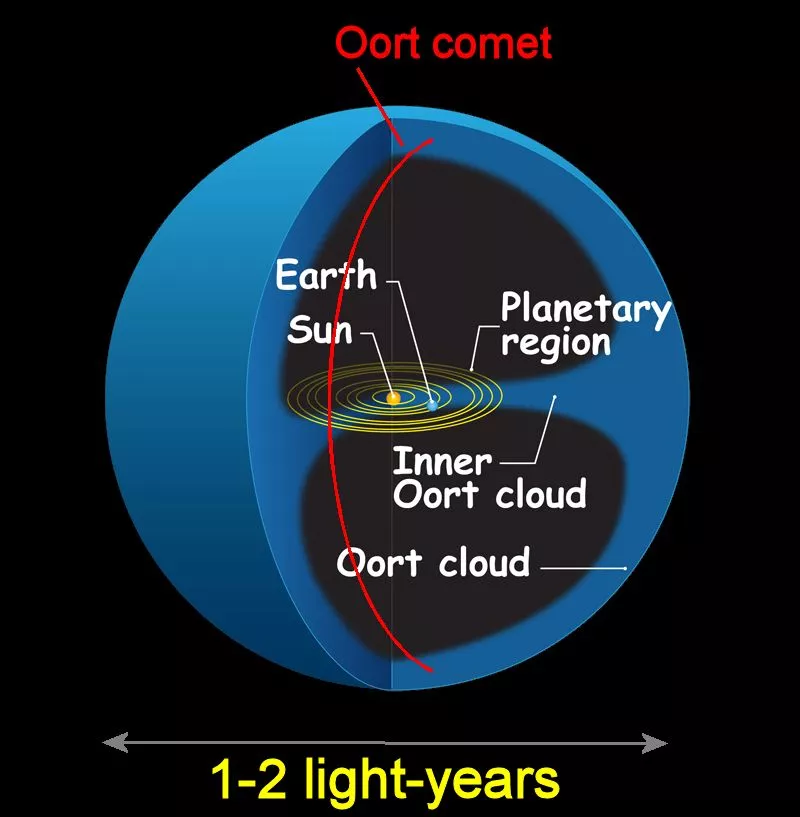The first comet discovered this year, Comet C/2013 A1, is currently projected to pass within about 23,000 miles (37,000 km) of the surface of Mars late in 2014. While this event in itself promises spectacular views for astronomers, the uncertainty of the comet's orbit includes a significant chance of an impact on Mars. If this happens, the impact would be hundreds of times more powerful than the asteroid impact that wiped out the dinosaurs on Earth.
C/2013 A1 was discovered on January 3, 2013, by experienced comet hunter Robert McNaught, who has discovered 74 comets and 467 asteroids. The discovery was made using a 0.5 m (20-inch) Schmidt telescope at Siding Spring Observatory in New South Wales, Australia. After his discovery, astrographs showing the comet on December 8 were found from the Catalina Sky Survey, and used to help establish the orbit.
At discovery, the new comet was well beyond the orbit of Jupiter. It is approaching the inner solar system from south of the ecliptic on a hyperbolic orbit, and is presently moving sunward at about 35 km/s (22 m/s). Based on its brightness and distance, the size of the new comet is estimated at roughly 20-40 kilometers (12.5-25 miles). For comparison, asteroid DA14, which recently passed within 27,700 km (17,200 miles) of Earth's surface, was only about 30 m (100 ft) in diameter.

The orbit of C/2013 A1 is typical of an Oort cloud comet. The Oort cloud is a remnant of the original protoplanetary disc from which the planets of the solar system were formed. It is thought to lie between about 0.05 and one light-year away from the Sun, and is the source of most hyperbolic and long-period comets.
What is not typical is that, based on the latest observations, the new comet's orbit passes Mars on October 19, 2014 at a distance of less than 37,000 km (23,200 miles). The comet's velocity relative to Mars at that point will be about 56 km/s (35 m/s). The uncertainty in the orbit indicates a collision with Mars is possible.
This would not be a minor collision. Rather, it would be a once in a billion years collision, generating a crater roughly 500 km (300 mi) in diameter. The equivalent explosive force would be in the range of five to twenty billion megatons of TNT. I'm not sure that any number can really let us understand the magnitude of the collision – does half a trillion Hiroshima bombs convey a more comprehensible image? Another comparison is that the impact is about equal to a tenth of a second of the Sun's total energy output focused on one spot on the Martian surface. Not a pleasant experience for any planet.
If there is no collision, which is still by far the most likely outcome, the close approach of a comet and Mars will still be one of the astronomic sights of the millennium. The coma of a comet can spread across an area a million kilometers wide. When a planet the size of Mars passes through the coma at 56 km/sec, there are likely to be a wide variety of spectacular vistas. An atom in the coma colliding with an atom of Mars' atmosphere will be heated to the temperature of the Sun's corona – on the order of a million degrees C. This will ionize the gases far beyond their normal level of ionization in a comet, and should produce bright aurora-like lights.
Given the relative orbital positions of Mars and Earth at the time of closest approach, the disk of Mars will only have an apparent diameter of ten seconds of arc. At a magnification of 100X, it will appear to be half the size of the Moon. On the other hand, the comet's coma will cover about 20 minutes of arc in the sky, so will just about fill the field of view at 100X. The natural coma will be difficult to see, as Mars will be perhaps 1000 times brighter. However, the special ionization effects may be much brighter than the natural coma.
The best observing advice I could offer at this point is to be ready for anything. If the predicted course holds, the nucleus of the comet will pass about a minute of arc distant from the planet. Viewing this can use all the magnification that your telescope and observing site can handle – probably 30-50X per inch of aperture. Observing the effects of Mars passing through the comet's coma should be viewed at lower magnification – perhaps 10-15X per inch. The sight of Mars within the coma and tail of a comet should also be impressive through binoculars. If a collision is predicted, consider using filters, as the brightness of the impact will be far brighter than an equivalent sized area on the Sun ... and burning trails of the impact flare on your retina is not advisable.
Source: NASA JPL




